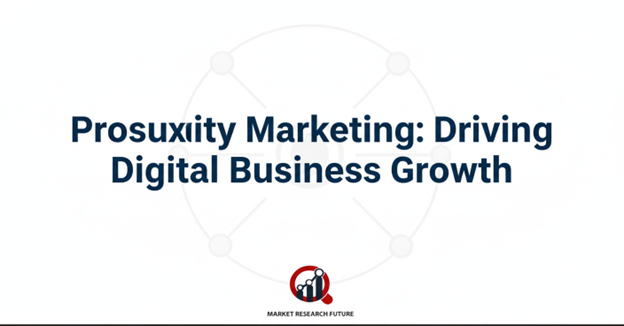Proximity Marketing: Driving Digital Business Growth

Proximity Marketing Market Overview
Proximity marketing is transforming how brands connect with consumers by delivering hyper-local, personalized messages at the right place and time. Leveraging technologies like Bluetooth, GPS, Wi-Fi, and NFC, proximity marketing enables businesses to engage customers within a 100–500-yard radius, offering timely promotions, product recommendations, and interactive experiences.
In today’s digitally connected marketplace, consumer attention is fleeting. Proximity marketing bridges the gap between online engagement and offline conversion, helping brands boost footfall, improve loyalty, and drive sales. With increased smartphone usage, growing adoption of location-based services, and the rise of mobile-first commerce, this marketing approach is emerging as a cornerstone of digital business growth strategies worldwide.
From retail and hospitality to entertainment and smart cities, proximity marketing offers real-time relevance, personalized engagement, and measurable ROI, making it one of the most effective tools for modern marketers.
What is Proximity Marketing?
Proximity marketing is a location-based marketing strategy that uses digital technologies such as Bluetooth beacons, geo-fencing, Wi-Fi, and NFC to deliver targeted messages to consumers when they are near a specific location.
Unlike traditional marketing channels like email or social media, proximity marketing engages users in the moment, based on their current location and contextual needs.
Key proximity triggers include:
- In-store Beacon Marketing: Beacons installed in retail stores detect customer presence and send personalized offers or product details via mobile apps.
- Geo-fencing: Virtual perimeters around stores or areas that trigger push notifications when a user enters or exits the zone.
- Mobile Apps: Integrated with GPS and beacons to deliver promotions, reminders, or loyalty points based on user behavior.
Shifting Consumer Psychology
Today’s consumers expect personalized, real-time interactions that add value to their shopping experience. Proximity marketing fulfils these expectations by providing instant incentives, exclusive deals, and context-aware content.
Key drivers shaping consumer preferences include:
- Desire for instant gratification and convenience
- Increased smartphone penetration and app usage
- Growing trust in location-based services
- Preference for personalized, non-intrusive marketing
- Expectation of seamless online-to-offline brand experiences
Key Market Growth Drivers
1. Rising Smartphone Penetration
With billions of mobile users worldwide, smartphones have become the primary channel for real-time engagement. Proximity marketing leverages this connectivity to deliver location-specific messages effectively.
2. Enhanced Customer Experience
By offering relevant, timely offers, brands can improve in-store experience, encourage impulse buying, and build long-term loyalty.
3. Integration with Loyalty Programs
Retailers use proximity campaigns to issue QR codes, digital coupons, or reward points, enhancing retention and driving repeat visits.
4. Adoption Across Industries
Beyond retail, sectors like hospitality, transportation, education, and events are adopting proximity marketing to guide visitors, enhance navigation, and improve service efficiency.
5. Advancements in IoT and Data Analytics
Integration with IoT devices and real-time analytics allows businesses to track engagement metrics, optimize campaigns, and refine targeting strategies.
Challenges
Despite its potential, proximity marketing faces certain hurdles:
- Privacy Concerns: Users are cautious about sharing location data, demanding strict compliance with GDPR and other regulations.
- App Dependency: Success depends on user opt-ins and active mobile apps.
- Technology Costs: Deploying beacons, sensors, and analytics platforms requires initial investment.
- Data Overload: Managing and interpreting vast location-based data can be complex.
- Limited Awareness: Small and medium enterprises may lack knowledge of implementation benefits.
To overcome these challenges, brands must focus on transparent data practices, user consent, and value-driven engagement.
Applications and Benefits
Applications
- Retail Stores: Personalized offers and real-time product recommendations
- Hospitality: Welcome messages, loyalty rewards, and event notifications
- Events & Exhibitions: Navigation assistance and booth promotions
- Transportation: Updates on schedules, offers, and nearby amenities
- Smart Cities: Citizen engagement and real-time alerts
Benefits
- Higher Engagement Rates through personalized outreach
- Increased Sales and Conversions from timely offers
- Improved Customer Loyalty with gamified rewards and loyalty points
- Enhanced Data Insights into customer behavior and movement patterns
- Cost-effective Marketing with measurable ROI
Regional Insights
- North America: Leading market driven by advanced retail ecosystems, strong tech adoption, and established mobile commerce infrastructure.
- Europe: Growth supported by regulatory transparency, consumer trust in location-based services, and focus on personalized engagement.
- Asia-Pacific: Fastest-growing region with massive smartphone adoption and digital-first consumer base in countries like China, India, and Japan.
- Latin America & Middle East: Emerging adoption fuelled by urbanization, digital transformation, and retail modernization.
Future Outlook
The future of proximity marketing lies in hyper-personalization, AI-driven insights, and cross-platform integration. As brands adopt AR/VR, wearables, and smart devices, proximity marketing will evolve into an omnichannel strategy enabling seamless digital-physical experiences.
Key trends shaping the future include:
- AI-powered predictive targeting
- Integration with 5G and IoT ecosystems
- Voice-based proximity alerts
- Privacy-first architecture ensuring user trust
- Expansion into smart retail and automated commerce
Conclusion
Proximity marketing represents a powerful convergence of technology, data, and consumer intent. By connecting brands with customers in real time and real space, it drives higher engagement, improved conversions, and loyal relationships.
As digital transformation accelerates, businesses that adopt location-based strategies will gain a competitive edge—turning everyday moments into meaningful brand interactions. With continued innovation, transparency, and personalization, proximity marketing is set to become an indispensable pillar of modern digital business growth.

Leave a Comment